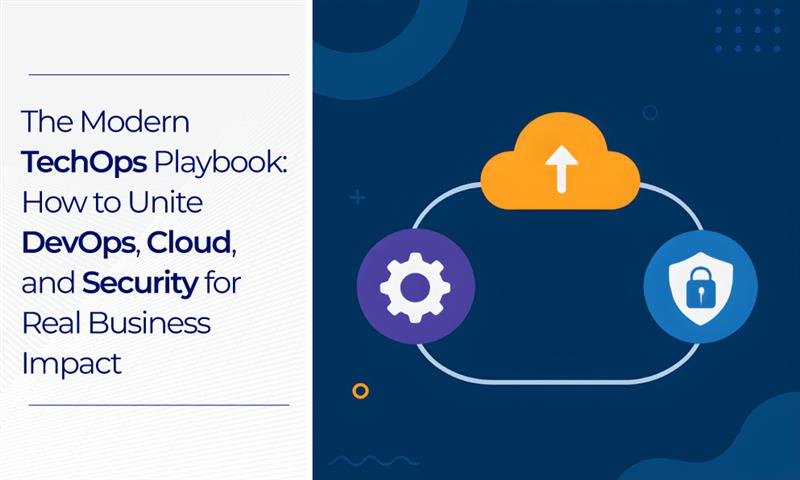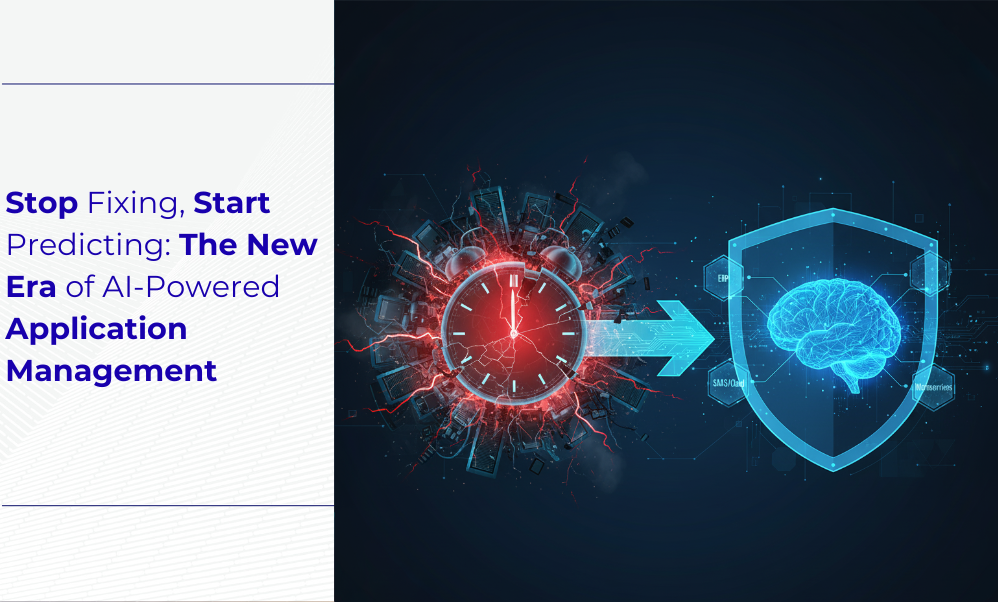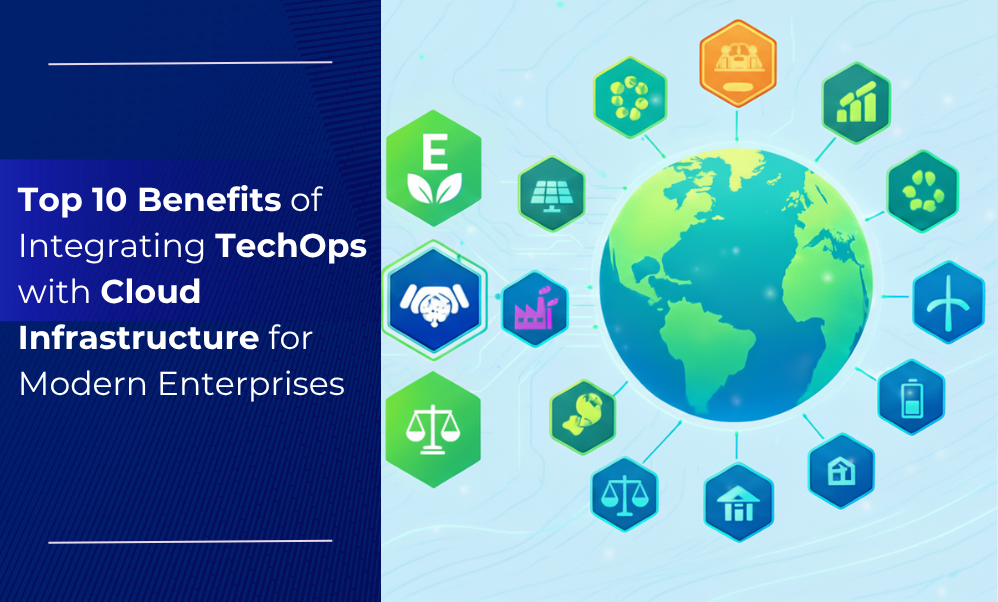Introduction
In today's digital landscape, turning operational friction into business impact requires a unified framework—The Modern TechOps Playbook—to break down silos between development, security, and cloud, converting internal friction into real business value. In the race for digital transformation, speed is everything. Enterprises are under constant pressure to deploy new features, respond to market demands, and deliver flawless customer experiences. Yet, this relentless pursuit of velocity often comes at a steep price: deep, dangerous fractures within an organization's core technology operations.
These fractures appear as functional silos: Development teams (DevOps) build fast, security teams (SecOps) struggle to keep up, and cloud operations (CloudOps) fight to control spiraling costs and complexity. This internal friction is the single greatest barrier to realizing true business value from digital transformation. The solution isn't a new tool or another team, but a holistic, unified strategy: The Modern TechOps Playbook. This isn't just another buzzword; it's a strategic framework for integrating development, security, and cloud operations into a single, automated, and secure engine.
As a global IT service leader, BJIT partners with enterprises to implement this innovative and reliable framework, guiding them to turn complex operational challenges into a powerful competitive advantage.
The Core Conflict: Why Siloed Operations Fail in the Cloud Era
The "wall of confusion" that DevOps was created to tear down has quietly been rebuilt. In the modern cloud-native world, it's no longer just Dev vs. Ops. New, more complex silos have emerged, and the resulting friction is palpable, creating a direct and negative business impact.
This dysfunction manifests in several critical ways:
- DevOps Teams vs. Budgets: Under pressure to deliver, development teams often provision oversized cloud resources or adopt new services without oversight, creating "shadow IT." This accelerates their specific project but creates technical debt and uncontrolled cloud spending (bill shock) for the entire organization.
- Security Teams vs. Speed: Security is often seen as a final, high-friction gate. When security teams are brought in at the last minute, they are forced to either block a release—delaying revenue—or approve code they haven't had time to vet, accepting unknown levels of risk.
- CloudOps Teams vs. Reality: A central cloud operations team, tasked with governance, struggles to enforce policies on an infrastructure they did not build and cannot fully see. This leads to critical gaps in compliance, misconfigurations, and an inability to optimize costs.
This organizational chaos has a measurable cost. Industry analysis consistently finds that security vulnerabilities identified in production are up to 100 times more expensive to fix than those found during the initial development phase (Jones, 2018). When teams are not united, the business pays the price in budget overruns, delayed time-to-market, critical security risks, and—most damagingly—lost market opportunities.
To illustrate the high cost of this friction, consider this quote from a Gartner report: "Through 2023, 90% of enterprises that fail to control cloud use will inappropriately share sensitive data, leading to compliance violations and business losses" (Gartner, 2021).
Let's contrast these two approaches side-by-side:
Breaking down these silos is the critical first step. BJIT’s strategic advisory services partner with enterprises to map this transformation, turning organizational friction into automated, high-velocity workflows.
The Modern TechOps Playbook: A Unified Framework for Business Value
A Modern TechOps model is not a new team, but rather a holistic philosophy enabled by technology. It fundamentally re-engineers how technology is delivered and managed by embedding security and cloud governance directly into the DevOps lifecycle.
The objective is to create a single, streamlined process built on a foundation of shared responsibility, deep automation, and continuous feedback. This playbook is built on three core components that must be developed in unison.
Component 1: DevSecOps – Integrating Security by Default
The first component of the Modern TechOps Playbook is that security is non-negotiable and must be integrated from day one. This is the "shift-left" principle, which moves security from a final gate to a continuous, automated process that starts with the developer.
The Business Impact: By catching vulnerabilities early, organizations avoid the six- or seven-figure costs of an emergency production patch or a public data breach. This is not just risk mitigation; it is active brand protection that builds customer trust and ensures development momentum is focused on innovation, not remediation.
This is achieved by automating a series of security "guardrails" directly within the CI/CD pipeline:
- Static Application Security Testing (SAST): Tools like SonarQube automatically scan source code for common vulnerability patterns (e.g., SQL injection, buffer overflows) before it is ever compiled.
- Software Composition Analysis (SCA): Modern applications are 80-90% open-source libraries. SCA tools like Trivy scan these dependencies for known vulnerabilities, preventing a "supply chain attack."
- Dynamic Application Security Testing (DAST): Tools like OWASP ZAP automatically test the running application in a staging environment, probing it from an attacker's perspective to find flaws like Cross-Site Scripting (XSS).
- Container Scanning: Ensures that the Docker container images themselves are free from malware and OS-level vulnerabilities before being pushed to a registry.
BJIT's Expertise: As a trusted, ISO 27001-certified partner, BJIT has a proven track record of building robust security foundations. Our dedicated cybersecurity team, which includes Certified Ethical Hackers (CEH) and eJPT-certified professionals, has conducted over 11+ major Vulnerability Assessment and Penetration Testing (VAPT) projects. We don't just find flaws; we build the systems to prevent them.
In a recent project for a public sector government agency, our team implemented a fully automated DevSecOps pipeline on Kubernetes. By integrating SonarQube (SAST), Trivy (Container Scanning), and OWASP ZAP (DAST), we ensured that security checks were automatically enforced with every single code commit. This made security a seamless, reliable, and low-friction part of development, not a bottleneck.
This level of "shift-left" automation is the first major step in unifying your operations. BJIT’s certified security and DevOps professionals partner with clients to co-build these secure pipelines, establishing a foundation of trust and reliability from the first line of code.
Component 2: CloudOps & FinOps – Automating Governance and Cost Control
The second component addresses the chaos of cloud sprawl. To unite DevOps and Cloud, manual configuration is the enemy. Manual server provisioning, network setup, and security group configuration are slow, impossible to audit, and the number one source of human error.
The TechOps playbook mandates Infrastructure as Code (IaC) as the single source of truth for all cloud resources. By defining infrastructure (servers, databases, load balancers, networks) in declarative code files using tools like Terraform or Ansible, the environment becomes:
- Repeatable: Spin up an identical production environment in minutes, not weeks.
- Auditable: Every change is logged in version control (like Git), showing who changed what, when, and why.
- Scalable: Manage thousands of resources across multiple cloud providers (AWS, Azure, GCP) from one codebase.
- Compliant by Default: IaC can programmatically enforce security rules, such as blocking public S3 buckets or ensuring encryption is always enabled.
This integrates directly with FinOps, or Cloud Financial Management, which provides a framework for tracking, analyzing, and optimizing cloud spend.
The Business Impact: This component provides direct, predictable control over cloud operational expenditure (Opex). It lowers the Total Cost of Ownership (TCO) by eliminating manual overhead and human error. Most importantly, it is a key business enabler, allowing companies to meet stringent compliance standards like PCI-DSS, HIPAA, or GDPR and legally enter highly-regulated markets.
BJIT's Expertise: Our team of 22+ professional, certified DevOps engineers has delivered over 45+ successful DevOps and Cloud projects for global clients. Our expertise is certified across all major public clouds, including AWS Certified Solutions Architect Professional, Microsoft Certified Azure Administrator, and Google Cloud Certified Associate Cloud Engineer.
For a leading US-based software company, our team architected a complex, resilient, and multi-region AWS environment. The primary drivers were cost-efficiency and compliance. Using a strict IaC approach, we automated the deployment of their entire stack—from AWS Elastic Beanstalk and ECS to Kinesis data streams and RDS databases—while programmatically enforcing the controls necessary for PCI, HIPAA, and GDPR compliance.
Similarly, for a leading Japanese multinational IT service company, we managed a multi-cloud (AWS and GCP) environment, with a key objective of building infrastructure to support rapid expansion into new regions. Our IaC and Site Reliability Engineering (SRE) practices provided the scalable, reliable, and cost-efficient foundation they needed for global growth.
This transformation to an automated, auditable, and cost-controlled infrastructure is fundamental to the Modern TechOps playbook. As an official AWS, Azure, and GCP partner, BJIT’s cloud-certified architects don't just manage your cloud; we build the governance framework that makes it a predictable and efficient asset for your business.
Component 3: AIOps & Observability – The Unified Command Center
The final component is to unite all operational data into a single pane of glass. You cannot manage, secure, or optimize what you cannot see. Traditionally, DevOps teams watch performance metrics (like CPU usage on Prometheus), while SecOps teams watch security logs (in a SIEM). When an incident occurs, both teams are looking at different data, leading to a slow, chaotic response.
A unified TechOps model breaks down this final silo by merging two key functions:
- Observability: Moving beyond basic monitoring (is it up or down?) to deep observability (why is it slow?). This involves correlating the "three pillars of observability": Metrics (from tools like Prometheus or Datadog), Logs (from Fluentd, Loki, or Splunk), and Traces (for microservices).
- Security Operations Center (SOC): This is the security nervous system. A modern SOC, powered by a SIEM (Security Information and Event Management) platform, monitors all infrastructure, network, and application logs 24/7/365.
This combination enables AIOps, which uses machine learning to analyze these combined data streams, detect anomalies, and predict issues before they impact users.
The Business Impact: This unified command center moves the entire organization from a reactive to a predictive state. Instead of discovering a problem when customers complain, you can fix performance issues before they impact revenue. Instead of discovering a breach after data is stolen, you can neutralize threats in real-time. The result is higher uptime, stronger reliability, and a vastly more resilient and trusted business.
BJIT's Expertise: BJIT provides comprehensive SOC as a Service and DevOps Managed Service, leveraging our deep cybersecurity and cloud expertise. Our case studies demonstrate our capability to provide actionable intelligence, not just raw alerts. We implement and manage sophisticated monitoring stacks using Prometheus, Grafana, Zabbix, and the ELK Stack.
Our SOC dashboards, as shown in our capability profile, provide clients with a clear, unified view of their security posture, including:
- Proactive Vulnerability Analysis: We provide "SOC - Vulnerability Analysis" charts that show a measurable reduction in vulnerabilities over time as our periodic scanning and remediation guidance take effect.
- File Integrity Monitoring (FIM): Our "SOC - File Integrity Monitoring" dashboards show exactly how many changes were made to critical systems, who made them, and when, providing a crucial audit trail.
- MITRE ATT&CK Vector analysis to map active threats.
- Real-time Compliance Dashboards: We implement "SOC - Compliance" charts that visually track adherence to PCI-DSS, HIPAA, GDPR, and NIST, instantly highlighting which clauses are non-compliant.
A unified command center provides the ultimate strategic advantage: moving from a reactive to a predictive operational state. BJIT’s DevOps Managed Service and SOC as a Service provide the 24/7/365 expertise to run this command center for you, ensuring your systems are resilient and your teams are free to innovate.
Implementing the Modern TechOps Playbook: A Phased Approach
Adopting the Modern TechOps model is a journey, not an overnight switch. It requires a phased approach, based on BJIT's proven "Initiation -> Ramp up -> Execution -> Delivery -> Maintenance" workflow, to build momentum and demonstrate value at each step. This structured methodology ensures a smooth, predictable transformation that aligns technology with core business objectives.
Phase 1: Assess & Strategize
The journey begins with an honest, data-driven assessment. You must understand your current state before you can map your future. This involves a comprehensive audit of your people, processes, and technology, focusing on identifying the areas of greatest friction and highest risk.
BJIT's Role: We begin with strategic workshops to understand business KPIs and pain points. Our vCISO as a Service offering provides the high-level leadership to guide this assessment, while our comprehensive VAPT services perform deep technical audits on your existing web applications, APIs, mobile apps, and cloud infrastructure. We don't just run scanners; our Certified Ethical Hackers manually identify critical vulnerabilities, as seen in our case studies where we found critical authentication flaws. We help you benchmark against global standards like ISO 27001 to create a clear, prioritized roadmap that focuses your investment on initiatives with the highest business impact.
Phase 2: Build the Foundation (CI/CD & IaC)
With a roadmap in place, the next step is to build the "software factory." This is the foundational plumbing for the entire TechOps model. This involves standardizing on a version control system (like Git) and building your first automated CI/CD pipelines (with tools like Jenkins, GitLab CI, or Azure DevOps). Concurrently, you begin cataloging all cloud resources and starting small, "brownfield" projects to bring existing infrastructure under the control of IaC (using Terraform or Ansible).
BJIT's Role: Our 22+ professional DevOps engineers are masters of automation. We accelerate this phase by deploying proven, reusable pipeline templates and IaC modules from our 45+ successful cloud projects. For a drone delivery R&D project, we rapidly built and managed their entire cluster management and CI/CD pipeline on Azure DevOps to deploy applications to an Azure Kubernetes Service (AKS) cluster. This deep expertise in Kubernetes, containerization, and CI/CD allows our clients to establish a stable, scalable, and automated foundation far more quickly than building from scratch.
Phase 3: Integrate Security and Compliance
Once the pipeline is flowing, you secure it. This is when you "shift-left" by integrating the automated security tools (SAST, DAST, SCA, container scanning) directly into the CI/CD pipeline, as demonstrated in our public sector case study. This phase also involves using IaC to enforce compliance policies, transforming your infrastructure from a manually audited state to being "compliant by default." This is also where you codify your "detect and alert" mechanisms, ensuring your SOC and operations teams get the right information instantly.
BJIT's Role: With Certified Ethical Hackers (CEH) and ISO 27001-certified professionals on staff, we don't just install tools. We configure them to find what matters, eliminating false positives and integrating security data into developer-friendly dashboards. Our expertise in ISMS Implementation for global standards ensures that the automated controls we build are directly mapped to the compliance requirements you must meet. We ensure security enables—rather than blocks—business velocity.
Phase 4: Observe, Manage & Optimize
With an automated, secure, and code-defined system, the final phase is one of continuous improvement. This is where you implement the unified command center, integrating observability (Prometheus, Grafana) and SOC (SIEM) data. You aggressively pursue FinOps, using our Cloud Cost Optimization services to analyze spending, rightsize instances, and eliminate waste. The goal is to create a positive feedback loop where savings are reinvested into further innovation.
BJIT's Role: This is the core of our DevOps Managed Service and SOC as a Service. We provide the experienced, global team to manage this optimized state 24/7. We ensure your systems are reliable, your costs are controlled, and your security posture is robust, allowing your internal teams to focus on core business innovation and new revenue streams. We turn your IT operations from a cost center into a strategic, reliable, and cost-efficient value driver.
This phased methodology ensures a predictable, high-ROI transformation. To start mapping your own journey from assessment to optimization, connect with BJIT’s TechOps strategy team.
The BJIT Advantage: Global Expertise, Japanese Quality
Successfully implementing a Modern TechOps playbook requires a partner with a rare combination of deep technical expertise, global reach, and an unwavering commitment to reliability.
BJIT is uniquely positioned as this trusted, global partner. We serve a diverse clientele, from manufacturing leaders in Japan to IT giants and innovative startups in the USA, Singapore, and the Netherlands. Our global footprint is strengthened by our strategic partnership with Etteplan and Marubeni group, reinforcing our significant European and japaness presence and global delivery capability.
This combination allows us to deliver innovative and scalable solutions with the meticulous Japanese quality our partners expect. We are not just a vendor; we are an experienced, cost-efficient, and reliable extension of your team.
Conclusion
The Modern TechOps Playbook is the essential strategy for surviving and thriving in the modern digital economy. It is the definitive antidote to the friction, risk, and waste of siloed IT.
By uniting DevOps, Cloud, and Security into a single, automated, and observable framework, organizations can finally break down the walls of confusion. They can move from a reactive, firefighting posture to a proactive, predictive, and high-velocity engine for sustainable growth. This is how modern technology stops being an operational cost and becomes the primary engine for real, measurable business impact.
Your TechOps transformation is a strategic journey. Let’s build your high-velocity, secure, and cost-efficient future together. Connect with the BJIT global team today.
References
Jones, C. (2018). A Guide to Software Economics. Capers Jones & Associates LLC.
IBM Security. (2023). Cost of a Data Breach Report 2023. IBM Corporation. Retrieved from https://www.ibm.com/reports/data-breach
Gartner, Inc. (2021, October 29). Predicts 2022: The Future of Cloud Is Distributed, Sustainable and Managed. Retrieved from https://www.google.com/search?q=httpsa%3A%2F%2Fwww.gartner.com%2Fen%2Farticles%2Fpredicts-2022-the-future-of-cloud-is-distributed-sustainable-and-managed









